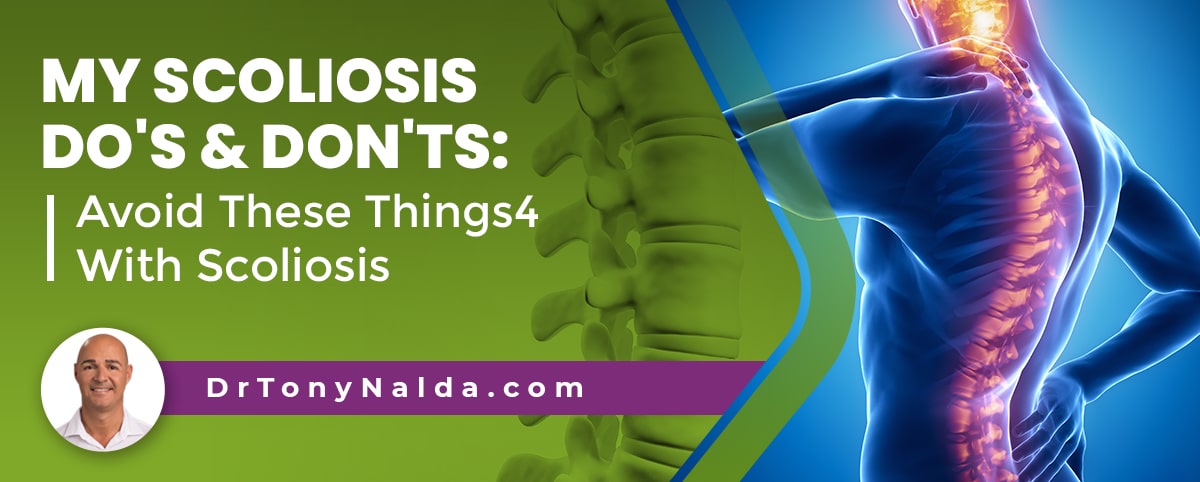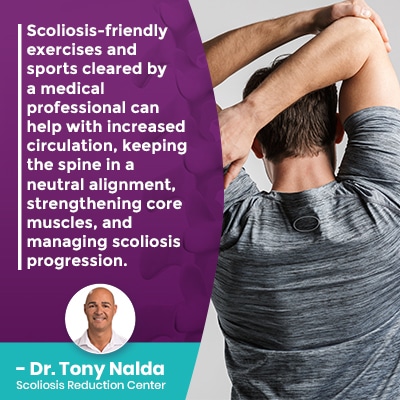My Scoliosis Do's & Don'ts: Avoid These Things With Scoliosis

It was once thought that a scoliosis diagnosis meant a life of limitations, but we've since learned how to manage and treat the condition proactively, and in most cases, scoliosis-specific exercises (SSEs) are an important facet of treatment; continue reading to understand the difference between general physical therapy exercises and those that have corrective potential.
When it comes to the dos and don'ts of scoliosis, stay safely active and get treatment, and don't participate in certain sports/exercises/activities that aren't considered scoliosis-friendly.
The most important do regarding scoliosis is to be proactive with treatment, so let's start with why that is so important.
Table of Contents
Scoliosis is a Progressive Condition
As a progressive condition, scoliosis has it in its nature to worsen over time.
Scoliosis is the development of an unnatural sideways spinal curve with rotation, making it a 3-dimensional condition.
The spine's natural curves make it stronger, more flexible, and better able to handle stress incurred during activity.
Scoliosis getting worse means the unhealthy spinal curve is increasing in size, and as the condition introduces a lot of uneven forces to the spine, its surrounding muscles and nerves, and the entire body, these forces also increase with progression, as do their effects.
As scoliosis progresses, it's becoming more severe, and this is based on a measurement known as Cobb angle:
- Mild scoliosis: Cobb angle measurement of between 10 and 25 degrees
- Moderate scoliosis: Cobb angle measurement of between 25 and 40 degrees
- Severe scoliosis: Cobb angle measurement of 40+ degrees
- Very-severe scoliosis: Cobb angle measurement of 80+ degrees
The condition's severity scale is the same as its progressive line, so even a diagnosis of mild scoliosis isn't indicative of where it will stay; only a proactive treatment plan can counteract the condition's progressive nature.
While we don't fully understand what causes all types of scoliosis to develop, we do know what triggers its progression: growth.
So for young patients and adolescents who are still growing, they are at risk for rapid-phase progression: another reason proactive treatment is so important.
Early Intervention is Invaluable
 While there are never treatment guarantees, early intervention does increase chances of treatment success.
While there are never treatment guarantees, early intervention does increase chances of treatment success.
As scoliosis progresses, the spine becomes increasingly rigid, making it less responsive to treatment.
In fact, in some of my adult patients who have progressed significantly before they are diagnosed and start treatment, which is more common than you'd think, some preparatory work has to be done, before starting the initial course of treatment, to establish a baseline level of spinal flexibility.
In addition, as scoliosis progresses, the condition's effects are also increasing, and it's far better to minimize those effects by preventing progression, than trying to reverse the effects once they've developed.
There are three main spinal sections, and a scoliosis curve can develop in any one of them: cervical spine (neck), thoracic spine (middle/upper back), and lumbar spine (lower back).
The longer a scoliotic spine is left untreated, the more it's likely to progress, and the more time the body has to adjust to its presence, and as it's not just the spine that maintains its natural curves, but also it surrounding muscles, muscle imbalance and strain also increases alongside progression; this is why increasing core strength is an important part of scoliosis treatment.
Speaking of scoliosis treatment, let's move on to what I mean when I say a proactive treatment plan is best.
Finding a Scoliosis Treatment Provider
Proactive scoliosis treatment means scoliosis patients start treatment as close to the time of diagnosis as possible, so patients can benefit from early intervention.
Scoliosis has varying underlying causes, and patient age, curvature location, and condition severity are important condition/patient factors that shape the design of effective treatment plans.
In addition, scoliosis treatment needs to be delivered by a scoliosis specialist; the condition is far too complex to be addressed by a general practitioner, just as general physical therapy exercises aren't specific enough to actually help correct a scoliosis.
Correcting structural scoliosis means impacting it on a structural level because its underlying nature is structural, so once again, achieving these types of results is beyond the scope of general chiropractic, requiring scoliosis-specific chiropractic for effective treatment.
People with scoliosis have two main scoliosis treatment approaches to choose between: traditional and conservative.
While the former was the dominant choice for years, this approach funnels scoliosis patients towards scoliosis surgery, which is a lengthy, costly, and risky procedure, and the reality is that many patients can be treated successfully with nonoperative treatment.
Conservative treatment, also known as chiropractic-centered, or functional works towards a curvature reduction on a structural level, uses physical therapy and scoliosis-specific exercises to increase core strength and address muscle imbalance so the spine is optimally supported, corrective bracing, and rehabilitation to further stabilize the spine.
A proactive treatment plan strives to prevent progression and integrates multiple forms of proactive treatment to do so by impacting the spine on every level.
An abnormal curvature of the spine needs to be addressed, and with treatment success, a curvature reduction is achieved, and impacting the condition's underlying structural nature means improving related symptoms such as postural deviation: uneven shoulders, hips, the development of a rib cage arch, to name a few.
As scoliosis is a highly variable condition, what one patient experiences isn't indicative of what others will face, but postural deviation in adolescents, and pain in adults, are the main symptoms.
So now that we've covered the dos of scoliosis, let's move on to the don'ts.
Things Scoliosis Patients Should Avoid
While life with scoliosis was once thought to be sedentary and limiting, that view has since changed; we now know that people with scoliosis can still thrive, and staying active is key to maintaining core strength, spinal flexibility, and overall health.
However, people with scoliosis do have to approach certain exercises, sports, and activities with caution to ensure they are not exacerbating muscle imbalance, the condition's effects, interfering with treatment, or are going to place the spine in an unnatural position for extended periods of time.
Activities that overuse one side of the body are not recommended for people with scoliosis because they exacerbate the imbalance that's already occurring, due to the condition's asymmetrical effects, and can increase related muscle imbalance and postural deviation: golf, tennis, bowling, etc.
Exercises and sports that involve hyperextending the spine and repeated jarring impact should also be approached with caution by people with scoliosis: diving, gymnastics, horseback riding and football.
Spinal compression occurs with repeated jarring motions and stress from impact, and the scoliotic spine is already facing compression; in fact, in adults, for whom the condition is compressive, compression of the spine and its surrounding muscles and nerves is the main cause of condition-related pain.
Finding a healthy level of physical activity is important for scoliosis patients, and while general exercise will have little corrective potential as a form of treatment, scoliosis-specific exercises are key to maintaining a strong core and activating certain areas of the brain to encourage postural remodeling and improving body positioning.
 Scoliosis-friendly exercises and sports cleared by a medical professional can help with increased circulation, keeping the spine in a neutral alignment, strengthening core muscles, and managing scoliosis progression.
Scoliosis-friendly exercises and sports cleared by a medical professional can help with increased circulation, keeping the spine in a neutral alignment, strengthening core muscles, and managing scoliosis progression.
A healthy spine is one that's strong, flexible, and as its design is based on movement, one that is strengthened by its activities, not strained, or put in unnatural positions.
And, of course, aligned with the most important do for scoliosis, is the most important don't: don't leave the condition untreated to progress unimpeded.
Conclusion
When it comes to the most important dos and don'ts of scoliosis, we're talking about treatment because it's how a diagnosis of scoliosis is responded to that has far-reaching effects.
As a progressive condition, scoliosis is virtually guaranteed to get worse over time, particularly if left untreated, or not treated proactively.
Whether a person has cervical, lumbar scoliosis, or scoliosis in the thoracic spine (the most common site), the most important decision to be made is how to treat it because different treatment approaches offer patients different potential outcomes.
While there are no treatment guarantees, a scoliosis curvature can be highly treatable, especially when people with scoliosis have the benefit of early detection and early intervention.
When it comes to things to avoid for people with scoliosis, we're talking about sports, activities, and exercises that strain the spine, place it in an unnatural position, exacerbate muscle imbalance by overusing one side of the body, and cause an increased risk of spinal compression and spinal injury.
Here at the Scoliosis Reduction Center, I apply a proactive conservative treatment approach that improves the overall health of the spine, and its surroundings, by impacting the condition on every level.
Part of my treatment approach involves providing guidance of how to cultivate a scoliosis-friendly lifestyle, including awareness of the condition's dos and don'ts.
Dr. Tony Nalda
DOCTOR OF CHIROPRACTIC
After receiving an undergraduate degree in psychology and his Doctorate of Chiropractic from Life University, Dr. Nalda settled in Celebration, Florida and proceeded to build one of Central Florida’s most successful chiropractic clinics.
His experience with patients suffering from scoliosis, and the confusion and frustration they faced, led him to seek a specialty in scoliosis care. In 2006 he completed his Intensive Care Certification from CLEAR Institute, a leading scoliosis educational and certification center.
About Dr. Tony Nalda
 Ready to explore scoliosis treatment? Contact Us Now
Ready to explore scoliosis treatment? Contact Us Now





